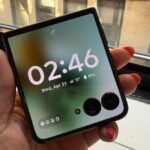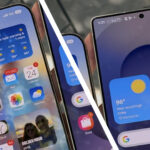Why you can trust TechRadar
We spend hours testing every product or service we review, so you can be sure you’re buying the best. Find out more about how we test.
JapanNext 5K: 30-second review
As the brand name implies, JapanNext is a Japanese company based in Tokyo, with offices in the “electric city” district of Akihabara, and its product development located in Isumi, part of Chiba Prefecture.
A successful brand in Japan, JapanNext started to expand into Europe two years ago, with offices in Paris and Bordeaux.
Offering a wide range of monitors, including 4K UHD, curved, ultra-wide, portable and business-friendly designs.
The JN-IPS275K-HSPC9 is a 27-inch 5K design with an integrated support arm that allows the monitor to easily switch between landscape and portrait orientation and vertical and screen angle adjustments.
Using IPS technology, this is most likely the same panel that I previously saw on the Alogic Clarity 27” Touch 5K, but in this context, there are no touch controls, and this monitor has only a single HDMI input.
However, at under 700 Euros, this is also a much cheaper option that delivers similar colour accuracy, resolution, PIP and excellent viewing angles.
And, because the screen won’t typically be touched, this one has a matte surface texture that reduces reflection significantly.
The major caveats of this option are that it is only available in Europe, and its popularity often means it is out of stock. With wider availability, this design might justify being included in our best 5K and 8K monitor round-up.
JapanNext 5K: Price and availability
- How much does it cost? €700
- When is it out? It available now
- Where can you get it? Direct from Japannext.fr or via online retailers like Amazon.fr
It’s tempting to wonder why Japan Next doesn’t increase the price for this 5K design, since it’s invariably out of stock, showing demand is obviously high for this €699 option.
The monitor can be bought via Amazon.fr, and because of that, it is possible to order it in the UK and other European countries.
The low price point for this 5K design makes this option significantly cheaper than the Alogic Clarity 5K Touch. However, the touch functionality does add a feature that the JapanNext monitor doesn’t offer.
It’s also a little cheaper than the ASUS Professional Monitor ProArt Display 5K PA27JCV, which looks remarkably similar.
Getting a colour-accurate 4K monitor from ASUS for closer to $500 is possible, making the extra resolution another 40% in cost.
JapanNext 5K: Specs
|
Model: |
JapanNext JN-IPS275K-HSPC9 |
|---|---|
|
Screen Size: |
27.0 inch (68.58 cm) |
|
Resolution: |
5120 x 2880 |
|
Compatibility: |
DisplayPort, USB-C, HDMI |
|
Number of Ports: |
7 |
|
Ports: |
1x USB-C, 1x HDMI, 1x DisplayPort, 3.5mm Audio, USB-B 3.0 (Sends Data to PC), 2x USB-A 3.0 (Accessories) |
|
Quoted colour spec: |
100% sRGB, 100% DCI-P3 |
|
Quoted contrast: |
2000:1 |
|
Panel depth: |
8 bit + HiFRC |
|
Display Technology: |
IPS |
|
Max Brightness: |
350 nits |
|
Size: |
408 x 614 x 191mm (LxDxH) with stand |
|
Weight: |
?5.7kg without stand |
|
Accessories included: |
Stand, HDMI cable, DisplayPort Cable, USB-C cable, USB-A cable, VESA mounting screws |
|
Touch capable: |
No |
|
Maximum refresh: |
60Hz |
|
Speakers: |
2x 3W Speakers |
|
Warranty: |
2 years |
JapanNext 5K: Design
- Minimalist design
- Silver and black plastic
- Rear lighting
When a portion of the target audience might be Apple customers, logic suggests that minimalist styling and silver colouring could attract sales. That appears to be the thinking at JapanNext, as the IPS275K (as I’ll call it from this point onwards) has the clean lines and metallic colour scheme of something designed in Cupertino.
That said, the aluminium colour scheme on the support arm here is painted plastic hiding an underlying steel structure. The monitor is black plastic, and the rear panel has an exceptionally neat pattern that isn’t symmetrical.
A slight head-scratcher is that the back of this screen looks much more involved than the front, and it even includes an LED light ring around the monitor connection that, by default, cycles RGB colours. Curiously, this is a gaming feature on what isn’t a gaming monitor.
It also differs from many other monitor designs because the PSU is integral to the panel, not via a laptop-style PSU brick. This choice makes the monitor slightly heavier but avoids misplacing the PSU if you move the display around.
The internal PSU is rated to power the screen, with a maximum of 45w consumption and 25w Eco mode, and also deliver up to 90w via the USB-C port to charge a connected laptop. With the ability to send so much power downstream, the display only managed an F-rating for power.
The included inputs are distinctly something-for-everyone, with one each of HDMI 2.0, DisplayPort 1.4 and USB-C. The monitor does support Picture-in-Picture mode for displaying multiple sources, should you need that capability with a single screen.
There is also a USB-C hub that uses a USB-B uplink and then dual USB-A ports to connect a mouse and keyboard, but JapanNext oversells this facility by calling it a KVM.
It also has AMD FreeSync support, which seems entirely moot given that the maximum refresh is 60Hz.
Something much more likely to be utilised is the ability to rotate the screen from landscape to portrait. But to do this requires that you elevate the monitor to the highest position on the support arm and then tilt it back to achieve the clearance to rotate it fully through 90 degrees. More vertical height might have made this easier, but it’s something you would get familiar with once you’ve switched it a few times. The screen isn’t orientation-aware, so the operating system must be adjusted to the new orientation.
One feature I didn’t care for was the edge-controlled buttons for the on-screen menu. Buttons that you can’t see what they do have always seemed a painfully dumb idea, as you are forced to learn what each does in the context of where you are in the menu and remember that for the next time (which you never do).
For those who like to tinker, the menu has many options for colour temperature, HDR, audio, multi-picture, and blue light, among other things. However, the menu is tedious to navigate, and a computer-side app would be much easier to operate.
What’s included in the box is slightly odd. There are cables for HDMI and USB-C, as well as the USB-A to USB-B cables to use the hub, but no DisplayPort cable. Given that DisplayPort is the preferred choice for connecting a desktop PC to a 5K screen, it seems odd that it wasn’t included.
You do get four VESA spacers, which are necessary if you wish to connect the panel to an alternative VESA support arm or mount it on the wall.
Overall, while it would have been nice to see more metal, the IPS275 K’s design is good, with the possible exception of the menu control buttons. But given that most people play with that only once before ignoring it forever, that’s unlikely to be a problem.
Most customers will purchase this display for the colour gamut and spoiler, and it doesn’t disappoint.
JapanNext 5K: Performance
- Strong Colours
- Limited brightness for HDR
|
Colour Gamut |
Percentage |
|---|---|
|
sRGB |
100% |
|
AdobeRGB |
93% |
|
P3 |
100% |
|
NTSC |
91% |
|
Rec2020 |
78% |
|
ACES AP1 |
74% |
|
ACES AP0 |
44% |
|
DaVinci |
44% |
|
Brightness/Contrast |
Row 8 – Cell 1 |
|
Maximum Brightness |
411:5 |
|
Maximum Contrast |
2090:1 |
The two selling points of this screen are the resolution and the colour accuracy.
But before covering those, we need to address the HDR elephant in the room, specifically that this screen, like the Alogic Clarity 5K Touch, isn’t bright enough for true HDR representation.
The quoted brightness is 350 nits, and it managed over 400 in testing, but that’s a long way short of the 1000-2000 nits needed for true HDR content. Mitigating that point a little, the contrast level on this display ranged, depending on brightness, from around 1540:1 to 2090:1, delivering excellent black levels.
However, for someone trying to edit HDR video content, this still doesn’t offer the necessary intensity range required.
As for the colour gamut, the range of colour is impressive, if slightly less than I saw with the Alogic display. And by a slight margin, the Clarity 5K Touch managed 46% of DaVinci, whereas this panel has 44% coverage. The slice of colour that the Alogic did better is mainly in the red spectrum, but there is a marginal difference in most gamuts. The most significant difference is NTSC, where the IPS275K manages 91%, whereas the Alogic manages 97%. But frankly, NTSC isn’t the standard that most people would consider definitive. That it’s strong on P3 (100%) and Rec2020 (74%) is probably more important.
There are monitors available with even better results than this, such as the Alogic, but not at this price or even close to it.
One aspect I need to mention, mostly because I discussed it in the Alogic review, is Visual Acuity, or the human eye’s ability to see 5K pixels.
In short, you need to be within 1.5ft or half a metre range, even with perfect vision, to be able to see a pixel, and at further distances, it’s impossible. That’s because the human eye can only differentiate items greater than 1/60th of a degree of arc.
If you think I’m being picky, then set the display scaling to 100% on a 5K display and see how usable the desktop is. Unless you’re a Golden Eagle, the icons and text are so small that it isn’t a practical environment for work.
For most purposes, a scaling factor of 200% is required, and possibly even greater if you don’t have ideal eyesight.
That does call into question the logic of having a 5K display, but it’s the reality of using these resolutions on a modern computer.
JapanNext 5K: Final verdict
The IPS275K falls into the affordable 5K category if you think that nearly 700 euros for a 27-inch display is good value. I’d accept that it’s better value than some 5K monitors, but for those wanting more display space and unwilling to pay for 8K, it might be better to use dual 4K displays.
The biggest issue here is the limited availability of stock for the European customer. That’s probably because Japanese buyers like this design, and it’s obvious why they might.
American customers are completely out of luck here, but it would likely cost more in that region if JapanNext offered it there.
JapanNext 5K: Report card
|
Value |
Cheap by 5K standards, but hardly inexpensive |
4 / 5 |
|
Design |
Minimalist with curious, game-friendly features |
4 / 5 |
|
Performance |
Great colour representation and resolution |
4.5 / 5 |
|
Total |
A good-quality screen, but availability is an issue |
4 / 5 |
Should you buy a JapanNext 5K?
Buy it if…
Don’t buy if…
For more screens with an excellent gamut, we’ve rounded up the best monitors for photo editing and the best monitors for video editing.
Read the full article here












